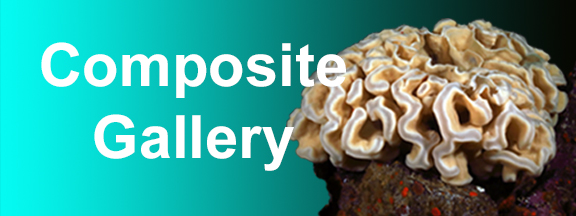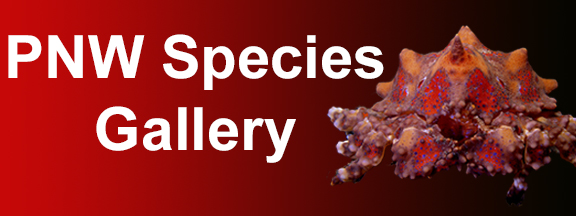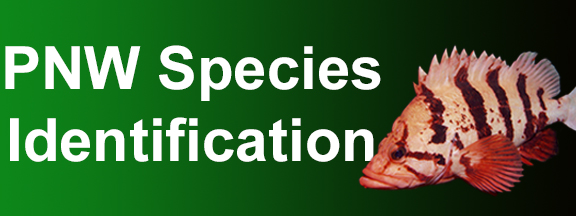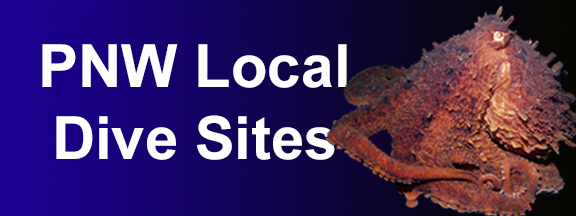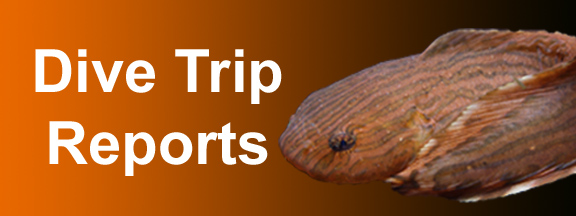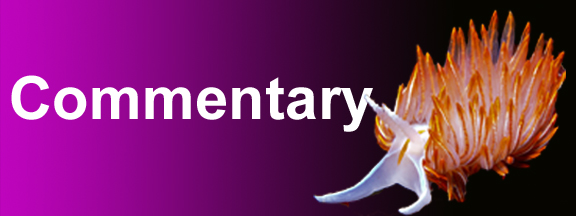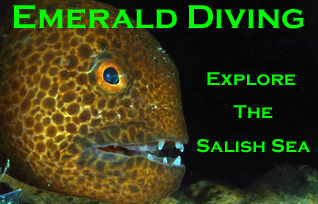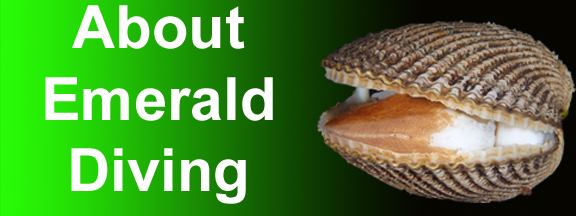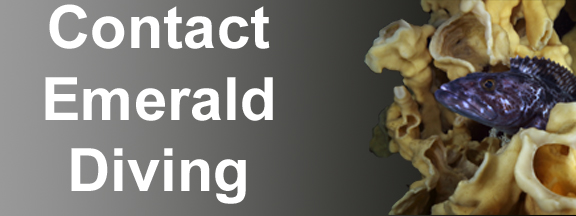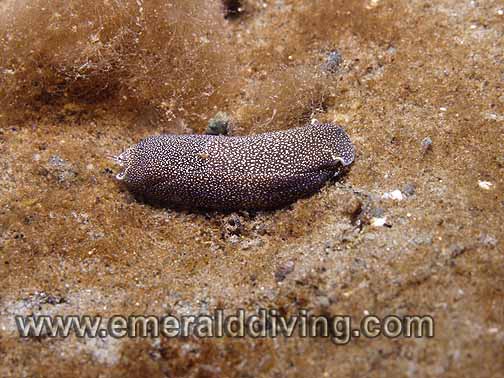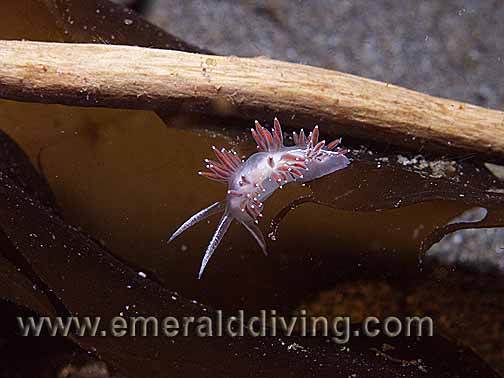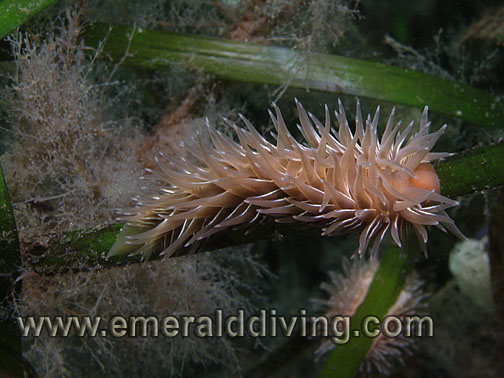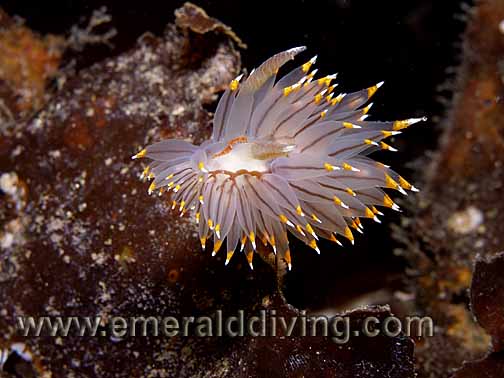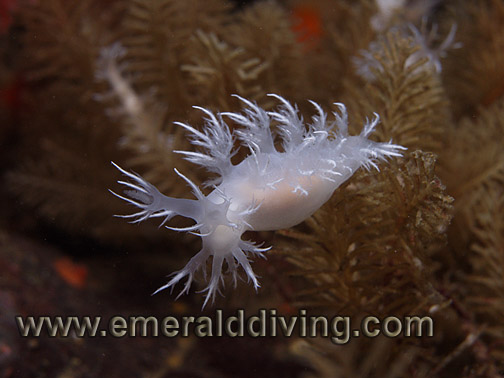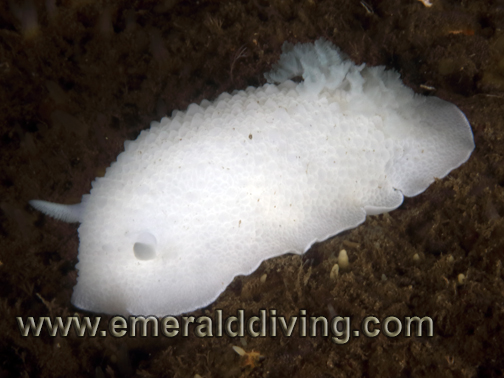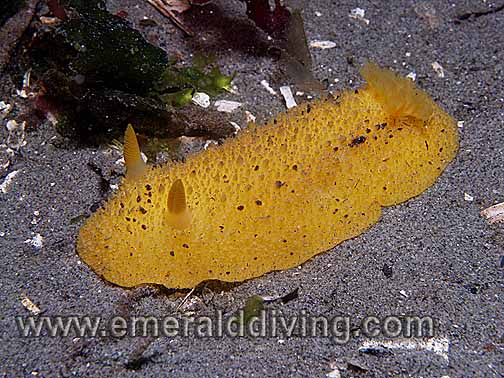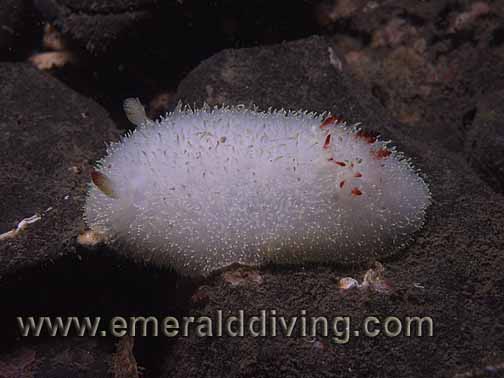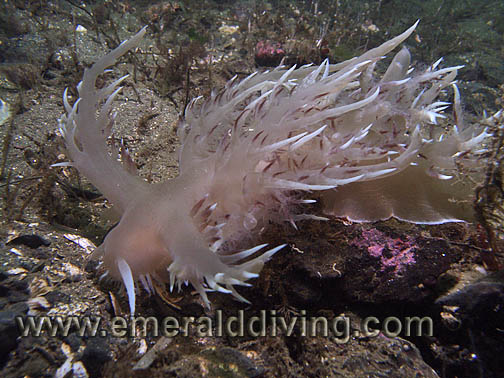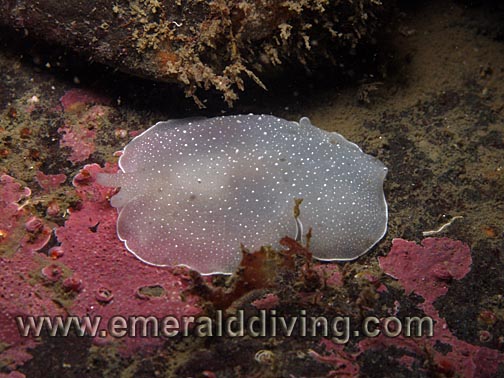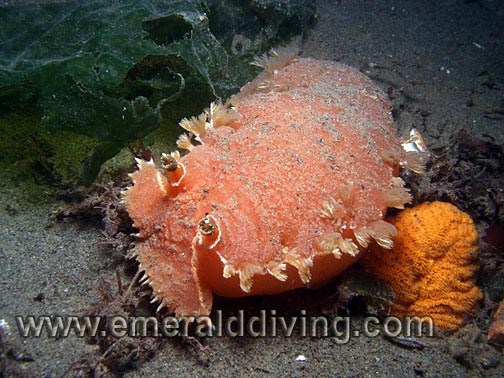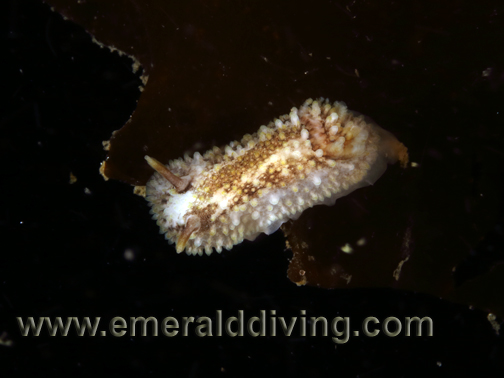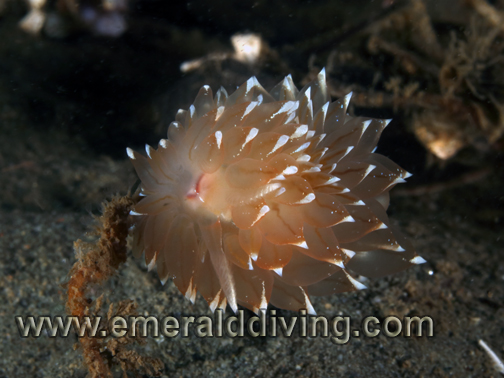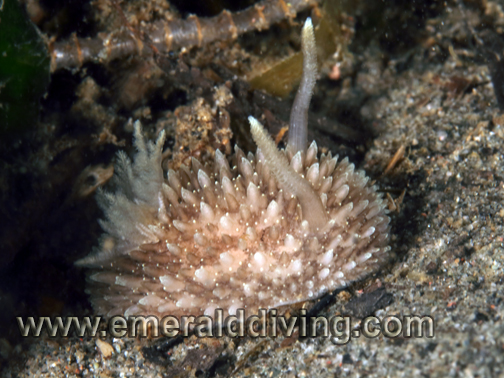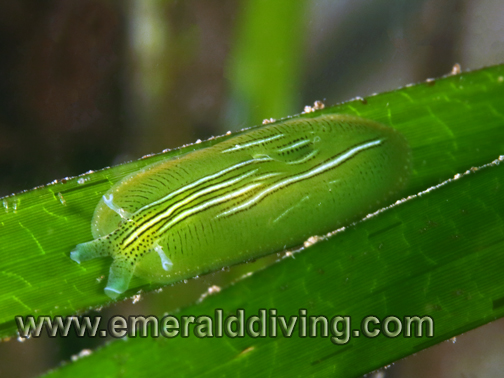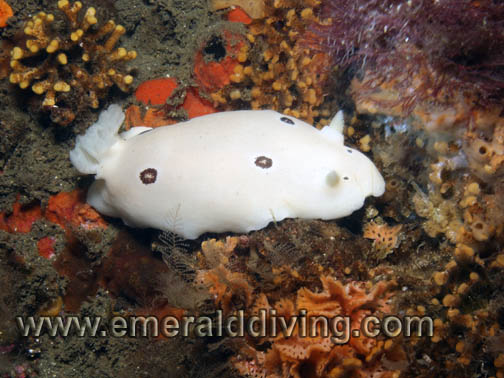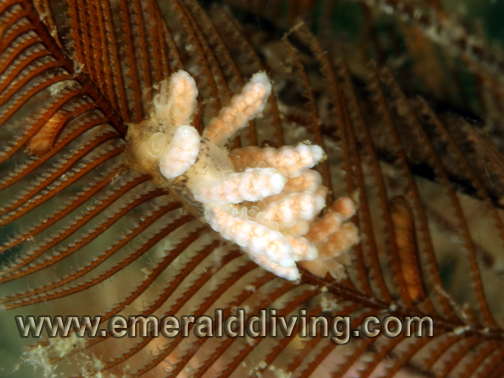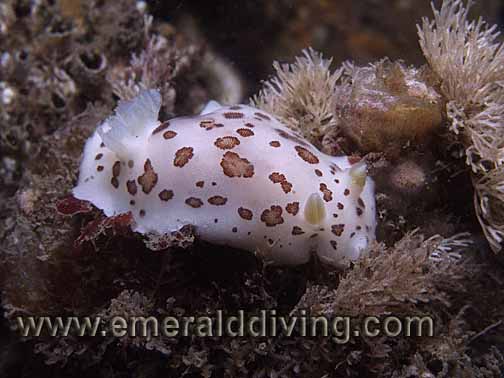

Freckled Pale Sea Lemon
Diaulula lentiginosa
Typical size: 6-10 length
ID: Dorid shape. Large pale yellow body with large dark and light brown patches of varying density. Small to medium sized tubercles cover entire body. Thick branchial plume on rear.
Image Location: Lawrence Point, Orcas Island, SJI
Comments: This is one of the largest nudibranch species in Washington water. My best luck finding this large sea slug is throughout Hood Canal and the San Juan Island.
Diaulula lentiginosa
Typical size: 6-10 length
ID: Dorid shape. Large pale yellow body with large dark and light brown patches of varying density. Small to medium sized tubercles cover entire body. Thick branchial plume on rear.
Image Location: Lawrence Point, Orcas Island, SJI
Comments: This is one of the largest nudibranch species in Washington water. My best luck finding this large sea slug is throughout Hood Canal and the San Juan Island.
Sea Lemon
Peltodoris nobilis
Typical size: 3-8 length
ID: Yellow or pale yellow dorid shaped body. Branchial plume is white. Body covered with flat yellow tubercles. Dark patches on body do not extend to tubercles.
Image location: Blakely Rock, Puget Sound
Comments: A very common and robust nudibranch found all over the Salish Sea. Similar to other large yellow dorids, this species has a distinctive white branchial plume and cool round bumps that are flat on top.
Peltodoris nobilis
Typical size: 3-8 length
ID: Yellow or pale yellow dorid shaped body. Branchial plume is white. Body covered with flat yellow tubercles. Dark patches on body do not extend to tubercles.
Image location: Blakely Rock, Puget Sound
Comments: A very common and robust nudibranch found all over the Salish Sea. Similar to other large yellow dorids, this species has a distinctive white branchial plume and cool round bumps that are flat on top.
Shaggy Mouse Nudibranch
Aeoldia loui
Typical size: 1-3 length
ID: Two distinct rows of dense cerata. White/crθme colored body, often with purple or grey on top (but not always). Cerata start in front of rhinophores.
Image location: KVI Tower Reef, Puget Sound
Comments: Will the real shaggy mouse please stand up? Ever-changing nudibranch research now has this species split from the species below. This species is not rare, but a seldom note the well camouflaged shaggy mouse nudibranch. When I do note this species, it is typically on rocks.
Aeoldia loui
Typical size: 1-3 length
ID: Two distinct rows of dense cerata. White/crθme colored body, often with purple or grey on top (but not always). Cerata start in front of rhinophores.
Image location: KVI Tower Reef, Puget Sound
Comments: Will the real shaggy mouse please stand up? Ever-changing nudibranch research now has this species split from the species below. This species is not rare, but a seldom note the well camouflaged shaggy mouse nudibranch. When I do note this species, it is typically on rocks.
Spotted Aglajid
Aglaja ocelligera
Typical size: 1-2 length
ID: Elongated, smooth, and rounded dark body with small white and/or yellow spots.
Image location: KVI Tower Reef, Puget Sound Comments: A super-strange little nudibranch that can easily be overlooked. The species appears to prefer soft substrates where broadleaf kelp is present, such as along the shallows at Three Tree Point or KVI Tower during summer and fall months.
Aglaja ocelligera
Typical size: 1-2 length
ID: Elongated, smooth, and rounded dark body with small white and/or yellow spots.
Image location: KVI Tower Reef, Puget Sound Comments: A super-strange little nudibranch that can easily be overlooked. The species appears to prefer soft substrates where broadleaf kelp is present, such as along the shallows at Three Tree Point or KVI Tower during summer and fall months.
White Dendronotid
Dendronotus albus
Typical size: 2-4 length
ID: Elongated, translucent white or lilac body. Up to seven sets of gill tufts tipped with white and/or orange. White stripe runs from the fourth pair of gill tufts to the tail.
Image location: KVI Tower Reef, Puget Sound
Comments: A very common species throughout the Salish Sea often found clinging to hydroids. This species used to be differentiate from Dendrontus diversicolour, but recent research resulted in the convergence.
Dendronotus albus
Typical size: 2-4 length
ID: Elongated, translucent white or lilac body. Up to seven sets of gill tufts tipped with white and/or orange. White stripe runs from the fourth pair of gill tufts to the tail.
Image location: KVI Tower Reef, Puget Sound
Comments: A very common species throughout the Salish Sea often found clinging to hydroids. This species used to be differentiate from Dendrontus diversicolour, but recent research resulted in the convergence.
Verrucose Aeolid
Flabellina verrucosa
Typical size: 1-2 length
ID: Red cerata tipped in white arranged in several clumps on either side of the body. Long smooth rhinophores. Stubby, smooth nose.
Image location: KVI Tower Reef, Puget Sound Comments: Another super-common species of the Salish Sea at certain times of the year. Populations of this species can explode during summer months. Easily differntiated from the Red Flabellina as the Red Flabellina has a protruding nose and shorter tail.
Flabellina verrucosa
Typical size: 1-2 length
ID: Red cerata tipped in white arranged in several clumps on either side of the body. Long smooth rhinophores. Stubby, smooth nose.
Image location: KVI Tower Reef, Puget Sound Comments: Another super-common species of the Salish Sea at certain times of the year. Populations of this species can explode during summer months. Easily differntiated from the Red Flabellina as the Red Flabellina has a protruding nose and shorter tail.
Yellow Dorid
Acanthodoris lutea
Typical size: 1 length
ID: Bright yellow/orange color, white branchial plume, distinctive brown tipped rhinophores, light yellow specks.
Image location: Elephant Wall, Hood Canal
Comments: I have only noted this nudibranch once even though its distinctive coloration make it an easy ID. Reportedly, this nudibranch emits a strong odor that resembles sandalwood when removed from the water - by why would anyone want to do that to this incredible little sea slug?
Acanthodoris lutea
Typical size: 1 length
ID: Bright yellow/orange color, white branchial plume, distinctive brown tipped rhinophores, light yellow specks.
Image location: Elephant Wall, Hood Canal
Comments: I have only noted this nudibranch once even though its distinctive coloration make it an easy ID. Reportedly, this nudibranch emits a strong odor that resembles sandalwood when removed from the water - by why would anyone want to do that to this incredible little sea slug?
Striped Nudibranch
Armina californica
Typical size: 3-6 length
ID: Elongated brown body with horizontal white stripes. White margin around foot. Club-like rhinophores.
Image location: Possession Pt. Fingers, Puget Sound Comments: The mighty hunter of the orange sea pen! I find this robust nudibranch on soft substrates where sea pens thrive. As this species approaches the sea pen, it burrows into the sand to attack the sea pen. Always address your challenges in life by the root...
Armina californica
Typical size: 3-6 length
ID: Elongated brown body with horizontal white stripes. White margin around foot. Club-like rhinophores.
Image location: Possession Pt. Fingers, Puget Sound Comments: The mighty hunter of the orange sea pen! I find this robust nudibranch on soft substrates where sea pens thrive. As this species approaches the sea pen, it burrows into the sand to attack the sea pen. Always address your challenges in life by the root...
Red Nudibranch
Dendronotus rufus
Typical size: 4-10 length
ID: White elongated body. Purple to red tipped branching cerata.
Image location: Blakely Harbor, Puget Sound
Comments: Another large and striking PNW sea slug! I seldom note red nudibranchs. My best luck for sighting this spectacular species is at Possession Point Fingers during summer months where I sometimes find these nudibranchs patrolling the underside of ledges.
Dendronotus rufus
Typical size: 4-10 length
ID: White elongated body. Purple to red tipped branching cerata.
Image location: Blakely Harbor, Puget Sound
Comments: Another large and striking PNW sea slug! I seldom note red nudibranchs. My best luck for sighting this spectacular species is at Possession Point Fingers during summer months where I sometimes find these nudibranchs patrolling the underside of ledges.
Red Flabellina
Himatina trophina based
Typical size: 2-3 length
ID: Dense rows of red and/or pink cerata tipped in white on either side of body. Relatively short rhinophores have very subtle ridges.
Image location: Three Tree Point, Puget Sound
Comments: Dense concentrations of red flabellina can be found during summer/fall months throughout Puget Sound and Hood Canal on soft substrates. Similar to the verrucose aeolid, this species tends to sport a shorter tail, longer nose, and paler red in the cerata.
Himatina trophina based
Typical size: 2-3 length
ID: Dense rows of red and/or pink cerata tipped in white on either side of body. Relatively short rhinophores have very subtle ridges.
Image location: Three Tree Point, Puget Sound
Comments: Dense concentrations of red flabellina can be found during summer/fall months throughout Puget Sound and Hood Canal on soft substrates. Similar to the verrucose aeolid, this species tends to sport a shorter tail, longer nose, and paler red in the cerata.
Shaggy Mouse Nudibranch
Aeolidia papillosa
Typical size: 1-3 length
ID: Two distinct rows of dense cerata. White/crθme colored body, often with purple or grey on top (but not always). Cerata start in front of rhinophores.
Image location: KVI Tower Reef, Puget Sound Comments: This shaggy mouse is now a different species than the species pictured above, I have only noted this species in the eel grass beds at KVI Tower Reef in 9 feet of water where is appeared to be feeding on anemones during summer months.
Aeolidia papillosa
Typical size: 1-3 length
ID: Two distinct rows of dense cerata. White/crθme colored body, often with purple or grey on top (but not always). Cerata start in front of rhinophores.
Image location: KVI Tower Reef, Puget Sound Comments: This shaggy mouse is now a different species than the species pictured above, I have only noted this species in the eel grass beds at KVI Tower Reef in 9 feet of water where is appeared to be feeding on anemones during summer months.
White Lined Dirona
Dirona albolineata
Typical size: 2-5 length
ID: Semi-translucent white or lavender colored body with triangular shaped cerata edged in bright white.
Image location: Three Tree Point, Puget Sound
Comments: This amazing looking nudibranch is apparently very robust as it is common throughout the Salish Sea. It seems at home on soft and hard substrates. Although typically predominately white, this nudibranchs diet can effect body color.
Dirona albolineata
Typical size: 2-5 length
ID: Semi-translucent white or lavender colored body with triangular shaped cerata edged in bright white.
Image location: Three Tree Point, Puget Sound
Comments: This amazing looking nudibranch is apparently very robust as it is common throughout the Salish Sea. It seems at home on soft and hard substrates. Although typically predominately white, this nudibranchs diet can effect body color.
Bi-colored Nudibranch
Janolus fuscus
Typical size: 1-2 length
ID: Translucent white body. Densely packed pointed cerata with maroon center and tipped w/yellow & white.
Image location: God's Pocket, Hurst island BC
Comments: Although fairly common, this striking nudibranch is always a favorite find. I regularly spot large specimens at Three Tree Point in spring on broadleaf kelp from shallow depths to over 90 feet deep. Don't confuse this nudibranch with the much less common frosty-tipped nudibranch.
Janolus fuscus
Typical size: 1-2 length
ID: Translucent white body. Densely packed pointed cerata with maroon center and tipped w/yellow & white.
Image location: God's Pocket, Hurst island BC
Comments: Although fairly common, this striking nudibranch is always a favorite find. I regularly spot large specimens at Three Tree Point in spring on broadleaf kelp from shallow depths to over 90 feet deep. Don't confuse this nudibranch with the much less common frosty-tipped nudibranch.
Cockerells Dorid
Laila cockerelli
Typical size: 0.75-1 length
ID: White body. Dorid shape with distinctive orange tipped papilla. Rhinophores tipped in red.
Image location: Strawberry Island, SJI
Comments: The Cockerell's dorid is a cool looking nudibranch with its bright white body, bulbous bright orange papilla, rhinophors, and sometimes orange spots. These is not an overly common nudibranch, but I note them fairly regularly at Keystone Jetty and at various sites through out the San Juans. They seem to like current stricken rocky reefs.
Laila cockerelli
Typical size: 0.75-1 length
ID: White body. Dorid shape with distinctive orange tipped papilla. Rhinophores tipped in red.
Image location: Strawberry Island, SJI
Comments: The Cockerell's dorid is a cool looking nudibranch with its bright white body, bulbous bright orange papilla, rhinophors, and sometimes orange spots. These is not an overly common nudibranch, but I note them fairly regularly at Keystone Jetty and at various sites through out the San Juans. They seem to like current stricken rocky reefs.
Dalls Dendronotid
Dendronotus dalli
Typical size: 3-5 length
ID: White or pinkish-white body with six or seven rows of white tipped gill tufts that are heavily branched and tipped in bright white.
Image location: Long Island, SJI
Comments: I usually note this nudibranch around invertebrate rich rocky reef areas in the San Juan Islands. Like the lion and giant nudibranch, this nudibranch is capable of swimming. This species is easily confused with the white dendronotid.
Dendronotus dalli
Typical size: 3-5 length
ID: White or pinkish-white body with six or seven rows of white tipped gill tufts that are heavily branched and tipped in bright white.
Image location: Long Island, SJI
Comments: I usually note this nudibranch around invertebrate rich rocky reef areas in the San Juan Islands. Like the lion and giant nudibranch, this nudibranch is capable of swimming. This species is easily confused with the white dendronotid.
Giant White Dorid
Doris odhneri
Typical size: 2-8 length
Distinctive markings: Dorid shaped white body with no color markings. Medium sized tubercles over entire body. White rhinophores and branchial plume on rear.
Image location: Point Lawrence, Orcas Island, SJI
Comments: The snow-ball of the sea slugs! I frequently note this nudibranch at certain sites in the SJIs, although have noted it less as the years go on. I have noted this species in a pale yellow color in the Hood Canal area.
Doris odhneri
Typical size: 2-8 length
Distinctive markings: Dorid shaped white body with no color markings. Medium sized tubercles over entire body. White rhinophores and branchial plume on rear.
Image location: Point Lawrence, Orcas Island, SJI
Comments: The snow-ball of the sea slugs! I frequently note this nudibranch at certain sites in the SJIs, although have noted it less as the years go on. I have noted this species in a pale yellow color in the Hood Canal area.
Hudson Dorid
Acanthodoris hudsoni
Typical size: 1-2 length
ID: White dorid shaped body covered in small white papillae tipped with yellow. Yellow margin. Long, prominent rhinophores. Rhinophores and gill plume are white.
Image location: Deadman Island, SJI
Comments: A very common species noted throughout the Salish Sea around rocky reef areas. Often confused with the Nainimo dorid which boasts rust colored rhinophores and branchial plume.
Acanthodoris hudsoni
Typical size: 1-2 length
ID: White dorid shaped body covered in small white papillae tipped with yellow. Yellow margin. Long, prominent rhinophores. Rhinophores and gill plume are white.
Image location: Deadman Island, SJI
Comments: A very common species noted throughout the Salish Sea around rocky reef areas. Often confused with the Nainimo dorid which boasts rust colored rhinophores and branchial plume.
Golden Dirona
Dirona aurantia
Typical size: 2-8 length
Distinctive markings: Dorid shaped white body with no color markings. Medium sized tubercles over entire body. White rhinophores and branchial plume on rear.
Image location: Point Lawrence, Orcas Island, SJI
Comments: Another wonderful and striking nudibranch, the golden dirona loves current swept rocky reef areas. I find this nudibranch throughout the San Juan Islands, but have also regularly found large specimens at Blakely Rock in Puget Sound.
Dirona aurantia
Typical size: 2-8 length
Distinctive markings: Dorid shaped white body with no color markings. Medium sized tubercles over entire body. White rhinophores and branchial plume on rear.
Image location: Point Lawrence, Orcas Island, SJI
Comments: Another wonderful and striking nudibranch, the golden dirona loves current swept rocky reef areas. I find this nudibranch throughout the San Juan Islands, but have also regularly found large specimens at Blakely Rock in Puget Sound.
Lion Nudibranch
Melibe leonina
Typical size: 3-8 length
ID: Translucent white or yellowish brown body, sometimes with white spots. Large frontal hood that can be extended to trap food drifting in the current. Cerata are disk shaped.
Image location: God's Pocket Bay, Hurst Island, BC
Comments: A seasonal nudibranch (summer/fall) that thrives amidst eel-grass and broadleaf kelp beds at shallow depth. This species swims by undulating its body. Also referred to as a hooded nudibranch - but I like lion nudibranch because it sounds more ferocious.
Melibe leonina
Typical size: 3-8 length
ID: Translucent white or yellowish brown body, sometimes with white spots. Large frontal hood that can be extended to trap food drifting in the current. Cerata are disk shaped.
Image location: God's Pocket Bay, Hurst Island, BC
Comments: A seasonal nudibranch (summer/fall) that thrives amidst eel-grass and broadleaf kelp beds at shallow depth. This species swims by undulating its body. Also referred to as a hooded nudibranch - but I like lion nudibranch because it sounds more ferocious.
Monterey Dorid
Doris montereyensis
Typical size: 2-6 length
ID: Dorid shaped yellow body. Yellow branchial plume and rhinophores. Black spots on body that can extend onto tubercles.
Image location: Alki Reef, Puget Sound
Comments: I commonly note this nudibranch on soft substrates. This species is easily mistaken for a sea lemon nudibranch (Anisodoris nobilis) which has a white branchial plume and is usually a paler yellow.
Doris montereyensis
Typical size: 2-6 length
ID: Dorid shaped yellow body. Yellow branchial plume and rhinophores. Black spots on body that can extend onto tubercles.
Image location: Alki Reef, Puget Sound
Comments: I commonly note this nudibranch on soft substrates. This species is easily mistaken for a sea lemon nudibranch (Anisodoris nobilis) which has a white branchial plume and is usually a paler yellow.
Nanaimo Dorid
Acanthodoris nanaimoensis
Typical size: 1-3 length
Distinctive markings: White dorid shaped body covered with small papillae tipped in yellow. Branchial plume and rhinophores tipped in rust.
Image location: Waterman Wall, Puget SoundI
Comments: Commonly noted around current-swept rocky reef areas. This nudibranch is often mistaken for a Hudson's dorid which lacks the rust coloration on the rhinophores are branchial plume. Nanaimo dorids are believed to primarily feed on bryozoans and ascidians.
Acanthodoris nanaimoensis
Typical size: 1-3 length
Distinctive markings: White dorid shaped body covered with small papillae tipped in yellow. Branchial plume and rhinophores tipped in rust.
Image location: Waterman Wall, Puget SoundI
Comments: Commonly noted around current-swept rocky reef areas. This nudibranch is often mistaken for a Hudson's dorid which lacks the rust coloration on the rhinophores are branchial plume. Nanaimo dorids are believed to primarily feed on bryozoans and ascidians.
Opalescent Nudibranch
Hermissenda crassicornis
Typical size: 0.5-3 length
ID: Densely packed long, narrow cerata tipped in orange. Distinctive orange stripe on head. Body color varies from light blue to white.
Image location: Steller Rock, Cape Flattery
Comments: The flamboyant rockstar of PNW nudibranchs looks like it's cerata are on fire! Commons throughout the Salish Sea are certain times of the year. Some years, thousands of these nubranch invade sites in Puget Sound, like KVI Tower reef - none bigger than 1".
Hermissenda crassicornis
Typical size: 0.5-3 length
ID: Densely packed long, narrow cerata tipped in orange. Distinctive orange stripe on head. Body color varies from light blue to white.
Image location: Steller Rock, Cape Flattery
Comments: The flamboyant rockstar of PNW nudibranchs looks like it's cerata are on fire! Commons throughout the Salish Sea are certain times of the year. Some years, thousands of these nubranch invade sites in Puget Sound, like KVI Tower reef - none bigger than 1".
Orange Spotted Nudibranch
Triopha modesta
Typical size: 3-8 length
ID: Elongaged white body with orange tipped gill tufts and rhinophores.
Image location: Pile Point, San Juan Island, SJI
Comments: Send in the clowns! This nudibranch is also referred to as a clown nudibranch and is one of the most common nudibranch species encountered when diving rocky reefs. Reported to feed on various bryozoans.
Triopha modesta
Typical size: 3-8 length
ID: Elongaged white body with orange tipped gill tufts and rhinophores.
Image location: Pile Point, San Juan Island, SJI
Comments: Send in the clowns! This nudibranch is also referred to as a clown nudibranch and is one of the most common nudibranch species encountered when diving rocky reefs. Reported to feed on various bryozoans.
Orange Peel Nudibranch
Tochuina gigantea
Typical size: 6-10 length
ID: Thick orange body with white margin and large tubercles tipped in white. White "fringe"(gills) line the top of the body.
Image location: Tatoosh Canyon, Cape Flattery
Comments: This aptly named nudibranch is one of the largest and most distincitive in WA waters. IT is also one of the rarer as I only note this species around Cape Flattery. It is much more common is BC. Feeds on sea strawberries, although I have seen it eat sea pens.
Tochuina gigantea
Typical size: 6-10 length
ID: Thick orange body with white margin and large tubercles tipped in white. White "fringe"(gills) line the top of the body.
Image location: Tatoosh Canyon, Cape Flattery
Comments: This aptly named nudibranch is one of the largest and most distincitive in WA waters. IT is also one of the rarer as I only note this species around Cape Flattery. It is much more common is BC. Feeds on sea strawberries, although I have seen it eat sea pens.
Dendronotus kamchaticus
Dendonotus kamchaticus
Typical size: 1" length
ID: White highlighted branchial plumes, medium density. White tipped rhinophore sheaths, no stripe on tail.
Image location: Lawson Bluff, Sucia Island, SJI
Comments: This species is part of the reason I love diving. It's not in many (any?) books! According to nudibranch expert Karin Fletcher, this species was identified as a separate species in 2015 in Russia. In appearance, it looks like a cross between Dentronotus albus and Dendronotus dalli.
Dendonotus kamchaticus
Typical size: 1" length
ID: White highlighted branchial plumes, medium density. White tipped rhinophore sheaths, no stripe on tail.
Image location: Lawson Bluff, Sucia Island, SJI
Comments: This species is part of the reason I love diving. It's not in many (any?) books! According to nudibranch expert Karin Fletcher, this species was identified as a separate species in 2015 in Russia. In appearance, it looks like a cross between Dentronotus albus and Dendronotus dalli.

Click here for nudibranch related terms and facts
Heath's Dorid
Geitordoris heathi
Typical size: 23 length
Distinctive markings: White or yellow dorid shaped body with tiny yellow brown or black specs. Branchial plume on rear.
Image location: Cone Island, SJI
Comments: Not rare, but not overly abundant either, the Heath's dorid is fairly distinctive with its roundish body that looks to have the texture of sand. I note this species most often at sites throughout the San Juan Islands and Hood Canal.
Geitordoris heathi
Typical size: 23 length
Distinctive markings: White or yellow dorid shaped body with tiny yellow brown or black specs. Branchial plume on rear.
Image location: Cone Island, SJI
Comments: Not rare, but not overly abundant either, the Heath's dorid is fairly distinctive with its roundish body that looks to have the texture of sand. I note this species most often at sites throughout the San Juan Islands and Hood Canal.
Coopers Dorid
Aldisa cooperi
Typical size: 1-1.5 length
ID: Solid yellow-orange body with small black spots on the centerline of the dorsum.
Image location: Tatoosh Canyon, Cape Flattery
Comments: I have only noted this species once, but I suspect I could find this species if I targeted it. Close inspection of encrusting sponges, which dominate parts of the Cape Flattery area, is a good place to start the search. The tiny black dots are tell-tale for this species. Sorry - these two have camera shy branchial plumes.
Aldisa cooperi
Typical size: 1-1.5 length
ID: Solid yellow-orange body with small black spots on the centerline of the dorsum.
Image location: Tatoosh Canyon, Cape Flattery
Comments: I have only noted this species once, but I suspect I could find this species if I targeted it. Close inspection of encrusting sponges, which dominate parts of the Cape Flattery area, is a good place to start the search. The tiny black dots are tell-tale for this species. Sorry - these two have camera shy branchial plumes.
Pilose Doris
Acanthodoris atrogriseata
Typical size: 1-2 length
ID: Small triangular papillae. Long rhinophores that bend slightly backwards. White, brown, or gold body.
Image location: Tatoosh Canyon, Cape Flattery
Comments: This is another of the hard-to-identify tiny white dorids that I can't ID until I look at pictures, although the extended rhinophores sometimes give it away. I only noted this nudibranch occasionally. It seems to prefer habitat that is more exposed.
Acanthodoris atrogriseata
Typical size: 1-2 length
ID: Small triangular papillae. Long rhinophores that bend slightly backwards. White, brown, or gold body.
Image location: Tatoosh Canyon, Cape Flattery
Comments: This is another of the hard-to-identify tiny white dorids that I can't ID until I look at pictures, although the extended rhinophores sometimes give it away. I only noted this nudibranch occasionally. It seems to prefer habitat that is more exposed.
Bushy-Back Nudibranch
Dendonotus frondosus
Typical size: 1 length
ID: Dendrontid shape with defined spiral rhinophore tips. Usually brown in color.
Image location: KVI Tower, Puget Sound
Comments: This is a miniature version of the nudibranch below - the specimen below a much more robust copy found up north in BC. I only occasionally note this nudibranch although they are not uncommon, most likely because they often look like a growth on broadleaf kelp and go undetected.
Dendonotus frondosus
Typical size: 1 length
ID: Dendrontid shape with defined spiral rhinophore tips. Usually brown in color.
Image location: KVI Tower, Puget Sound
Comments: This is a miniature version of the nudibranch below - the specimen below a much more robust copy found up north in BC. I only occasionally note this nudibranch although they are not uncommon, most likely because they often look like a growth on broadleaf kelp and go undetected.
Giant Nudibranch
Dendronotus iris
Typical size: 4-10 length
ID: White or red dendronotid body with long, branching gill tufts. Large size
Image Location: Pulali Point Wall, Hood Canal
Comments: One of the coolest PNW nudibranchs, this Dendronotus specializes in hunting tube-dwelling anemone and will rear up and "dive" into the center of the anemone to attack. It is also a pelagic species and can "swim" by undulating its body. Look for it where tube-dwelling anemones flourish.
Dendronotus iris
Typical size: 4-10 length
ID: White or red dendronotid body with long, branching gill tufts. Large size
Image Location: Pulali Point Wall, Hood Canal
Comments: One of the coolest PNW nudibranchs, this Dendronotus specializes in hunting tube-dwelling anemone and will rear up and "dive" into the center of the anemone to attack. It is also a pelagic species and can "swim" by undulating its body. Look for it where tube-dwelling anemones flourish.
California Berthella
Berthella californica
Typical size: 2-3 length
ID: White or orange rounded body with speckles. No branchial plume. Highlighted margin. Two tubular shaped rhinophores.
Image location: Flagpole, Hood Canal
Comments: This is a very distinctive nudibranch with it's bright spots and two very close together tubular rhinophores. Although not overly common, they are not rare. I note them most often at Hood canal dive sites, and less often in the SJI.
Berthella californica
Typical size: 2-3 length
ID: White or orange rounded body with speckles. No branchial plume. Highlighted margin. Two tubular shaped rhinophores.
Image location: Flagpole, Hood Canal
Comments: This is a very distinctive nudibranch with it's bright spots and two very close together tubular rhinophores. Although not overly common, they are not rare. I note them most often at Hood canal dive sites, and less often in the SJI.
Giant Nudibranch - Juvenile
Dendronotus iris
Typical size: 2-3 length
ID: White or red dendronotid body with long, branching gill tufts.
Image location: Three Tree Point, Puget Sound
Comments: I have only noted a juvenile Dendronotus iris a handful of times in over 1500 Salish Sea dives. Ironically, I have never seen an adult version of this nudibranch at this site where this photo was taken. Note the tri-colored gill tufts.
Dendronotus iris
Typical size: 2-3 length
ID: White or red dendronotid body with long, branching gill tufts.
Image location: Three Tree Point, Puget Sound
Comments: I have only noted a juvenile Dendronotus iris a handful of times in over 1500 Salish Sea dives. Ironically, I have never seen an adult version of this nudibranch at this site where this photo was taken. Note the tri-colored gill tufts.
Pink Nudibranch
Tritonia tetraquerta
Typical size: 5-8 length
ID: Thick, pink, "square" body with frontal veil trimmed in white. White fringe (gills) along top edges of body.
Image location: Alki Reef, Puget Sound
Comments: Look for this rare species amidst orange seapens on sandy substrates. Populations of this species have seemingly declined over the last 10-15 years for unknown reason. Note the orange seapen trying to hide in an attempt to note become dinner for this nudibranch.
Tritonia tetraquerta
Typical size: 5-8 length
ID: Thick, pink, "square" body with frontal veil trimmed in white. White fringe (gills) along top edges of body.
Image location: Alki Reef, Puget Sound
Comments: Look for this rare species amidst orange seapens on sandy substrates. Populations of this species have seemingly declined over the last 10-15 years for unknown reason. Note the orange seapen trying to hide in an attempt to note become dinner for this nudibranch.
Bushy-Back Nudibranch
Dendonotus frondosus
Typical size: 3 length
ID: Dendrontid shape with defined spiral rhinophore tips. Usually brown in color.
Image Location: Quatsino, NW Vancouver Island
Comments: Things often grow bigger up north, and that is the case with this particular nudibranch which I imaged during a circumnavigation of Vancouver Island. Canadian version of the nudibranch makes looks like it is on serious steroids compared to it's US relative. Look in hydroid fields for this nudibranch.
Dendonotus frondosus
Typical size: 3 length
ID: Dendrontid shape with defined spiral rhinophore tips. Usually brown in color.
Image Location: Quatsino, NW Vancouver Island
Comments: Things often grow bigger up north, and that is the case with this particular nudibranch which I imaged during a circumnavigation of Vancouver Island. Canadian version of the nudibranch makes looks like it is on serious steroids compared to it's US relative. Look in hydroid fields for this nudibranch.
Pomegranate Aeolid
Cuthona punicea
Typical size: 1 length
ID: Smooth rhinophores, lavender coloration to rhinophores with white markings.
Image location: Pearse Island, Johnstone Strait, BC
Comments: This tiny nudibranch is a true specialist! I it exclusively associated with raspberry hydroids, which are currently only known to exist in the northeast Vancouver Island area.
Cuthona punicea
Typical size: 1 length
ID: Smooth rhinophores, lavender coloration to rhinophores with white markings.
Image location: Pearse Island, Johnstone Strait, BC
Comments: This tiny nudibranch is a true specialist! I it exclusively associated with raspberry hydroids, which are currently only known to exist in the northeast Vancouver Island area.
Three Lined Aeolid
Orienthella trilineata
Typical size: 2 length
ID: Three white lines run along the top of the body. Red-colored cerate concentrated in isolated clumps.
Image location: Browning Wall, BC
Comments: The three lined nudibranch is super-common throughout the San Juan Islands and BC. Similar to the verrucose aeolid and red flabellina, nature did us a favor by highlighting this species with three bright white stipes along the body. Commonly found on invertebrate crusted, current swept rocky reefs.
Orienthella trilineata
Typical size: 2 length
ID: Three white lines run along the top of the body. Red-colored cerate concentrated in isolated clumps.
Image location: Browning Wall, BC
Comments: The three lined nudibranch is super-common throughout the San Juan Islands and BC. Similar to the verrucose aeolid and red flabellina, nature did us a favor by highlighting this species with three bright white stipes along the body. Commonly found on invertebrate crusted, current swept rocky reefs.
Cadlina
Cadlina sp.
Typical size: up to 1.75 length
ID: Dorid shape, distinctive bright spots (yellowish-white) along margin that extend to rhinophores.
Image location: Long Island Wall, SJI
Comments: Another nudibranch I just don't note too often. In fact Karin, can't positive ID this nudibranch from this image (hence it is listed as Cadlina sp.). The bright white spots help differentiate it from the yellow margin nudibranch.
Cadlina sp.
Typical size: up to 1.75 length
ID: Dorid shape, distinctive bright spots (yellowish-white) along margin that extend to rhinophores.
Image location: Long Island Wall, SJI
Comments: Another nudibranch I just don't note too often. In fact Karin, can't positive ID this nudibranch from this image (hence it is listed as Cadlina sp.). The bright white spots help differentiate it from the yellow margin nudibranch.

Barnacle-Eating Nudibranch
Onchidoris bilamellata
Typical size: less than 1 length
ID: Rounded papillia on back, short rhinophores. Coloration can vary, but usually brown/yellow.
Image location: KVI Tower, Puget Sound
Comments: I don't note these nudibranchs often, but they are fairly common. Their coloration and size blends in perfectly amongst a cluster of barnacles. This little guy was transversing broadleaf kelp in search of greener - or whiter - pastures which made spotting it easy.
Onchidoris bilamellata
Typical size: less than 1 length
ID: Rounded papillia on back, short rhinophores. Coloration can vary, but usually brown/yellow.
Image location: KVI Tower, Puget Sound
Comments: I don't note these nudibranchs often, but they are fairly common. Their coloration and size blends in perfectly amongst a cluster of barnacles. This little guy was transversing broadleaf kelp in search of greener - or whiter - pastures which made spotting it easy.
Stubby Dendronotus
Dendronotus subramosus
Typical size: up to 1.5" length
ID: Stubby body (lack of an extended exterior beyond the gills). Tufted gills along back. Typically found amongst its quarry as pictured here: the ostrich plume hydroid
Image location: Pile Point, San Juan Island, SJI
Comments: This nudibranch can often be found amongst ostrich-plume hydroid fields throughout the San Juan Islands which it appears to use as feeding grounds.
Dendronotus subramosus
Typical size: up to 1.5" length
ID: Stubby body (lack of an extended exterior beyond the gills). Tufted gills along back. Typically found amongst its quarry as pictured here: the ostrich plume hydroid
Image location: Pile Point, San Juan Island, SJI
Comments: This nudibranch can often be found amongst ostrich-plume hydroid fields throughout the San Juan Islands which it appears to use as feeding grounds.
Burrowing Aeolid
Cumaotus sp.
Typical size: 0.5"
ID: Translucent white body. Long, thin cerata tipped in white.
Image location: Alki Beach, Puget Sound
Comments: This little nudibranch can be really hard to find. Not only is it small, but it buries itself in the sand, making burrowing aeolid recon dives essentially a "Mission Impossible". I have only seen this nudibranch once, and it surfaced just long enough for a pic, then disappeared back in the sand.
Cumaotus sp.
Typical size: 0.5"
ID: Translucent white body. Long, thin cerata tipped in white.
Image location: Alki Beach, Puget Sound
Comments: This little nudibranch can be really hard to find. Not only is it small, but it buries itself in the sand, making burrowing aeolid recon dives essentially a "Mission Impossible". I have only seen this nudibranch once, and it surfaced just long enough for a pic, then disappeared back in the sand.
Frosty-Tipped Nudibranch
Janolus gelidus
Typical size: 1-2 length
ID: Very similar to the bi-colored nudibranch, but missing the yellow coloration on the end of the cerata. This species looks more opaque as well.
Image Location: Redondo Beach, Puget Sound
Comments: This cool little nudibranch is relatively scarce - in more than 1000 Puget Sound dives, I have noted species once, Then on that dive, I encountered 6 all in the same area. I suspect like many nudibranchs, they may be seasonal.
Janolus gelidus
Typical size: 1-2 length
ID: Very similar to the bi-colored nudibranch, but missing the yellow coloration on the end of the cerata. This species looks more opaque as well.
Image Location: Redondo Beach, Puget Sound
Comments: This cool little nudibranch is relatively scarce - in more than 1000 Puget Sound dives, I have noted species once, Then on that dive, I encountered 6 all in the same area. I suspect like many nudibranchs, they may be seasonal.
Acanthodoris brunnea
Acanthodoris brunnea
Typical size: 0.5-1" length
ID: Long cerata combines with bright white flecking throughout the body and long rhinophores.
Image location: Redondo Beach, Puget Sound
Comments: This is another is the small nudibranchs that really blends in due to coloration and size. I have only noted this species at Redondo Beach - usually in pairs on the end of worm stalks. However, they seem to travel in groups and if I carefully look around, I can find others.
Acanthodoris brunnea
Typical size: 0.5-1" length
ID: Long cerata combines with bright white flecking throughout the body and long rhinophores.
Image location: Redondo Beach, Puget Sound
Comments: This is another is the small nudibranchs that really blends in due to coloration and size. I have only noted this species at Redondo Beach - usually in pairs on the end of worm stalks. However, they seem to travel in groups and if I carefully look around, I can find others.
Tri-color Nudibranch
Polycera tricolor
Typical size: 1 length
ID: Striking yellow, black, and white color combination can;t really be mistaken for anything else.
Image location: Rainy Bay, Barkley Sound
Comments: This striking species can't be mistaken for any other. In the Pacific Northwest, this species is unique to Barkley Sound. We found numerous specimens during night dives in Rainy Bay at mid to shallow depths amongst the broadleaf kelp attached to rocks.
Polycera tricolor
Typical size: 1 length
ID: Striking yellow, black, and white color combination can;t really be mistaken for anything else.
Image location: Rainy Bay, Barkley Sound
Comments: This striking species can't be mistaken for any other. In the Pacific Northwest, this species is unique to Barkley Sound. We found numerous specimens during night dives in Rainy Bay at mid to shallow depths amongst the broadleaf kelp attached to rocks.
Knoutsodonta jannae
Knoutsodonta jannae
Typical size: upto 0.75 length
ID: Bumps on the back are longer and club-shaped. Lives in broads on broadleaf kelp.
Image location: Redondo Beach, Puget Sound
Comments: This is another of the tiny white nudibranchs found in the PNW. I only note this species on broadleaf kelp, often invested with kelp bryozoan. Typically, if I can find one, I can find at least several others in relatively close proximity.
Knoutsodonta jannae
Typical size: upto 0.75 length
ID: Bumps on the back are longer and club-shaped. Lives in broads on broadleaf kelp.
Image location: Redondo Beach, Puget Sound
Comments: This is another of the tiny white nudibranchs found in the PNW. I only note this species on broadleaf kelp, often invested with kelp bryozoan. Typically, if I can find one, I can find at least several others in relatively close proximity.
Yellow Margin Nudibranch
Cadlina luteomarginata
Typical size: 2-3 length
ID: White body covered with prominent white tubercles tipped in yellow. Yellow margin around foot. White branchial plume.
Image location: Possession Pt. Fingers, Puget Sound
Comments: Noted throughout Washington water on soft and hard substrates. Compared to other nudibranch, the this species maintains a very flat profile. This is another species that is very quick to retract its branchial plume when approached.
Cadlina luteomarginata
Typical size: 2-3 length
ID: White body covered with prominent white tubercles tipped in yellow. Yellow margin around foot. White branchial plume.
Image location: Possession Pt. Fingers, Puget Sound
Comments: Noted throughout Washington water on soft and hard substrates. Compared to other nudibranch, the this species maintains a very flat profile. This is another species that is very quick to retract its branchial plume when approached.
Red Sponge Nudibranch
Rostanga pulchra
Typical size: 0.5 length
ID: Distinctive rhinophores! Orange-red color, no spots.
Image location: Blakely Harbor Fingers, Puget Sound
Comments: This is a tiny nudibranch that is typically found around red sponges, which it consumes. Because it is the same color as the sponge, it can be very difficult to spot. The image of this specimen was captured at Blakely Harbor Fingers, where there are no red sponges, so it obviously has a broader diet than it's name suggests.
Rostanga pulchra
Typical size: 0.5 length
ID: Distinctive rhinophores! Orange-red color, no spots.
Image location: Blakely Harbor Fingers, Puget Sound
Comments: This is a tiny nudibranch that is typically found around red sponges, which it consumes. Because it is the same color as the sponge, it can be very difficult to spot. The image of this specimen was captured at Blakely Harbor Fingers, where there are no red sponges, so it obviously has a broader diet than it's name suggests.
Taylor's Sea Hare
Phyllaplysia taylori
Typical size: 0.5-2 length
ID: Flat bright green body with white and black stripes running lengthwise.
Image location: Alki Beach, Puget Sound
Comments: It is hard to mistake this super-cool looking nudibranch for another species - except eelgrass. This flat, green nudibranch blends in near-perfectly with lades of eel grass, which this species is exclusively associate with. I have seen mass congregation of this species at Alki Beach in 10-15 feet of water during summer.
Phyllaplysia taylori
Typical size: 0.5-2 length
ID: Flat bright green body with white and black stripes running lengthwise.
Image location: Alki Beach, Puget Sound
Comments: It is hard to mistake this super-cool looking nudibranch for another species - except eelgrass. This flat, green nudibranch blends in near-perfectly with lades of eel grass, which this species is exclusively associate with. I have seen mass congregation of this species at Alki Beach in 10-15 feet of water during summer.
San Diego Dorid
Diaulula sandiegensis
Typical size: 2-5 length
ID: Dorid shaped smooth white body with small black patches or loops along the back. White branchial plume.
Image location: Tatoosh Canyon, Cape Flattery
Comments: I find this species typically on hard substrates. Until recently, this was considered the same species as Diaulula odonoghuei. My observation is this species can grow much larger than Diaulula odonoghuei. If only the small white dorids were this easy to ID.
Diaulula sandiegensis
Typical size: 2-5 length
ID: Dorid shaped smooth white body with small black patches or loops along the back. White branchial plume.
Image location: Tatoosh Canyon, Cape Flattery
Comments: I find this species typically on hard substrates. Until recently, this was considered the same species as Diaulula odonoghuei. My observation is this species can grow much larger than Diaulula odonoghuei. If only the small white dorids were this easy to ID.
Doto columbiana
Doto columbiana
Typical size: 0.5 length
ID: Very small, beaded branchial plumes. Black extends down the sides, not just on the back, and there is little to no white speckles/frosting on the rhinophores
Image location: Lawrence Point, Orcas Island, SJI
Comments: Dotos often look like tiny bits of fuzz stuck on hydroids. Renowned nudibranch expert Karin Fletcher suspects this species is Doto columbiana, but with out examining any associated egg masses it is hard for certain.
Doto columbiana
Typical size: 0.5 length
ID: Very small, beaded branchial plumes. Black extends down the sides, not just on the back, and there is little to no white speckles/frosting on the rhinophores
Image location: Lawrence Point, Orcas Island, SJI
Comments: Dotos often look like tiny bits of fuzz stuck on hydroids. Renowned nudibranch expert Karin Fletcher suspects this species is Doto columbiana, but with out examining any associated egg masses it is hard for certain.
Diamond Back Nudibranch
Tritonia festiva
Typical size: 2-5 length
ID: Elongated translucent white body. Prominent frontal veil. Gill tufts aligned in rows along side of body.
Image location: Lawrence Point, Orcas Island, SJI
Comments: This is a super-cool looking nudibranch that has a wide variation of patterns on it back, including flamboyant rows of gill tufts and elaborate back design. These nudibranchs are often very common thought current swept rocky reefs in the SJI, although I find them in Puget Sound as well.
Tritonia festiva
Typical size: 2-5 length
ID: Elongated translucent white body. Prominent frontal veil. Gill tufts aligned in rows along side of body.
Image location: Lawrence Point, Orcas Island, SJI
Comments: This is a super-cool looking nudibranch that has a wide variation of patterns on it back, including flamboyant rows of gill tufts and elaborate back design. These nudibranchs are often very common thought current swept rocky reefs in the SJI, although I find them in Puget Sound as well.
A big "thank you" to Karin Fletcher for helping me keep this section current. The scientific names of many of these nudibranchs seem to change very quickly. Karin's insight into nudibranchs is unparalleled. Thank you Karin!
Doto kya
Doto kya
Typical size: 0.5 length
ID: Frosted and sheathed rhinopores, typivcslly no black specs on the back (although this specimen exhibits black spots).
Image location: Lawrence Point, Orcas Island, SJI
Comments: I believe this is Doto kya due to the rhinophore configuration, however Doto kya should not have black spots on the body. Doto ID can be difficult at best and an inexact observational science.
Doto kya
Typical size: 0.5 length
ID: Frosted and sheathed rhinopores, typivcslly no black specs on the back (although this specimen exhibits black spots).
Image location: Lawrence Point, Orcas Island, SJI
Comments: I believe this is Doto kya due to the rhinophore configuration, however Doto kya should not have black spots on the body. Doto ID can be difficult at best and an inexact observational science.
Porcupine Dorid
Diaphorodoris lirulatocauda
Typical size: 0.5 length
ID: Long, smooth rhinophore with white frosting, "spikey" cereta along body.
Image location: Point Lawrence, Orcas Island, SJI
Comments: Yet another tiny white dorid that will easily go unnoticed during a dive. It helps this one is on a contrasting background. This species is very similar to the pilose dorid, but with slightly shorter rhinophores with white forsting and a more opaque body.
Diaphorodoris lirulatocauda
Typical size: 0.5 length
ID: Long, smooth rhinophore with white frosting, "spikey" cereta along body.
Image location: Point Lawrence, Orcas Island, SJI
Comments: Yet another tiny white dorid that will easily go unnoticed during a dive. It helps this one is on a contrasting background. This species is very similar to the pilose dorid, but with slightly shorter rhinophores with white forsting and a more opaque body.
Dendronotus robilliardi
Dendronotus robilliardi
Typical size: 1" length
ID: White or orange tipped cerata, 5-7 rows of branchial plumes. White stripes on rhinophore sheaths and tail.
Image location: Long Island, SJI
Comments: This is a juvenile of the species, and I have only noted this species at Long Island. It is very similar to Dendronotus albus, which only has 4-5 pairs of branchial plumes. This specimen is only about 1 cm in length.
Dendronotus robilliardi
Typical size: 1" length
ID: White or orange tipped cerata, 5-7 rows of branchial plumes. White stripes on rhinophore sheaths and tail.
Image location: Long Island, SJI
Comments: This is a juvenile of the species, and I have only noted this species at Long Island. It is very similar to Dendronotus albus, which only has 4-5 pairs of branchial plumes. This specimen is only about 1 cm in length.
Leopard Dorid
Diaulula odonoghuei
Typical size: 2-4 length
ID: Dorid shaped smooth white body with small black dense patches extending to the mantle. White branchial plume.
Image location: Edmonds UW Park, Puget Sound
Comments: Leopard dorid is not a recognized common name, but it just fits! This species is often mistaken for a San Diego dorid, but is a separate species. I often found these common nudibranch thought the Salish Sea on hard and soft substrates and along the rope-lines at Edmond's Underwater Park.
Diaulula odonoghuei
Typical size: 2-4 length
ID: Dorid shaped smooth white body with small black dense patches extending to the mantle. White branchial plume.
Image location: Edmonds UW Park, Puget Sound
Comments: Leopard dorid is not a recognized common name, but it just fits! This species is often mistaken for a San Diego dorid, but is a separate species. I often found these common nudibranch thought the Salish Sea on hard and soft substrates and along the rope-lines at Edmond's Underwater Park.
Ancula
Ancula sp.
Typical size: 0.5 length
ID: Yellow-tipped cerata and rhinophores. Translucent body.
Image location: Alki Beach, Puget Sound
Comments: I have only noted these super tiny nudibranchs in about 70 feet of water amongst the brown, scrubby hydroids at both Redondo and Alki Beaches. When I find one I will typically fins three of four others nearby. These little guys are really hard to find, never mind photograph.
Ancula sp.
Typical size: 0.5 length
ID: Yellow-tipped cerata and rhinophores. Translucent body.
Image location: Alki Beach, Puget Sound
Comments: I have only noted these super tiny nudibranchs in about 70 feet of water amongst the brown, scrubby hydroids at both Redondo and Alki Beaches. When I find one I will typically fins three of four others nearby. These little guys are really hard to find, never mind photograph.
Salt-and-Pepper Nubibranch
Aegires albopunctatus
Typical size: 1" length
ID: Tritonia shaped body with thick white cylindrical tubercles along entire body and distinctive black or brown spots.
Image location: Alki Beach, Puget Sound
Comments: I have only seen this tiny nudibranch twice - both times when diving off Alki Beach in 70 fsw amongst the brown scrubby hydroids. These nudibranchs are very small and can be easily overlooked when there is other white debris (such as shell fragments) present.
Aegires albopunctatus
Typical size: 1" length
ID: Tritonia shaped body with thick white cylindrical tubercles along entire body and distinctive black or brown spots.
Image location: Alki Beach, Puget Sound
Comments: I have only seen this tiny nudibranch twice - both times when diving off Alki Beach in 70 fsw amongst the brown scrubby hydroids. These nudibranchs are very small and can be easily overlooked when there is other white debris (such as shell fragments) present.

